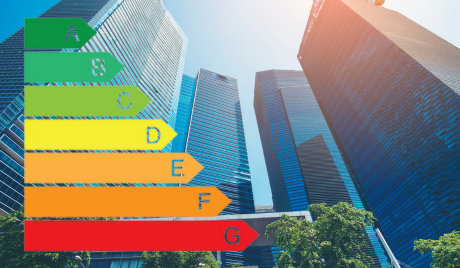By 8 December 2025, certain public and private sector buildings in South Africa must publicly display their Energy Performance Certificates (EPCs). This article shares the latest key information around EPCs in South Africa, that building owners and managers need to know.
What are EPCs, and why are they important?
An EPC provides a snapshot of a building’s yearly operational energy performance by measuring energy consumption per square metre per year. This is shown in a colour-coded score from A-G, like the energy labels you would find on appliances.
In the same way that drivers check the fuel consumption of a car before renting or buying it, knowing the energy performance of a building empowers potential buyers or tenants to make a more informed decision.
Made effective in 2020, the EPC Regulations state that buildings will need to display their EPC by December 2025.
Knowing the energy performance of a building empowers potential buyers and tenants to make informed decisions. Once inefficiencies are identified, improvements can be made by building owners. It is hoped that this will be a great boost for energy efficiency in South Africa, since the first step toward lowering energy consumption is knowing energy consumption.
GBCSA urges building owners to know and show their energy performance
Which buildings are affected?
Public sector buildings greater than 1 000m² and private sector buildings greater than 2 000m² are affected. If these buildings are offices, places of assembly, and places of instruction as per the occupancy classes below, then they must publicly display their Energy Performance Certificates (EPCs) by 8 December 2025.
CLASS OF OCCUPANCY:
A1: Entertainment and public assembly – Occupancy where persons gather to eat, drink, dance or participate in other recreation.
A2 : Theatrical and indoor sport – Occupancy where persons gather for the viewing of theatrical, operatic, orchestral, choral, cinematographical or sport performances.
A3 : Places of instruction – Occupancy other than primary or secondary schools, where students or other persons assemble for the purpose of tuition or learning.
A3 : Places of instruction – Occupancy where school children assemble for the purpose of tuition or learning
G1 : Offices – Large multi-storey office buildings, banks, consulting rooms and similar uses with lifts and energy consuming services that operate on a typical daytime occupancy.
G1 : Offices – Stand-alone blocks and / or campus of buildings that form an office park but operate separately
Towards Net Zero
Understanding the energy performance of a building is a vital first step on the journey to a net zero carbon building. Knowing the energy usage intensity of a building can support the energy efficiency retrofitting of that building, and ultimately the conversion to a net zero carbon building.
The GBCSA strongly advocates for net zero carbon buildings. These are very highly energy efficient buildings, with the remainder of the power required for the operation of the building provided by renewable energy sources.
The motivation for net zero carbon buildings is driven by South Africa’s National Development Plan (NDP) goals and local climate change commitments, which include the C40 Global Net Zero Carbon Buildings Declaration. Johannesburg, Tshwane, Cape Town and eThekwini are C40 cities and signatories to the 2018 declaration, alongside 24 other global cities.
These cities have committed to developing regulations and/or planning policy to ensure new buildings operate at net zero carbon by 2030 and all buildings reach net zero carbon status by 2050.
Meeting these commitments will require a step change in building energy efficiency policies and regulations in most cities. But meeting the commitments is possible.
For more information download our guide, GETTING TO ZERO: A guide to developing net zero carbon buildings in South Africa.
The guide includes case studies of projects that have already achieved net zero carbon status in South Africa.
To find out more, visit Sanedi



